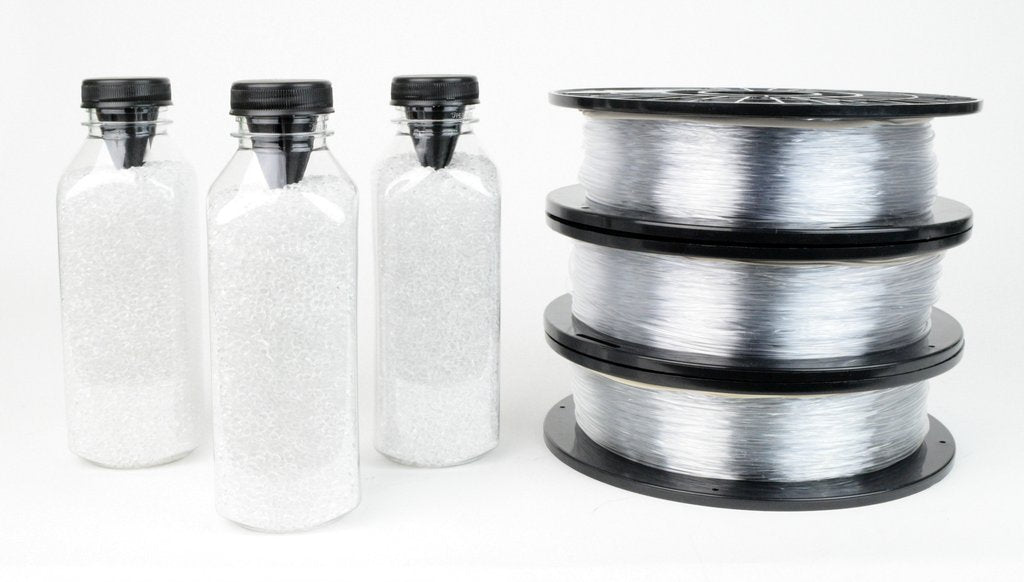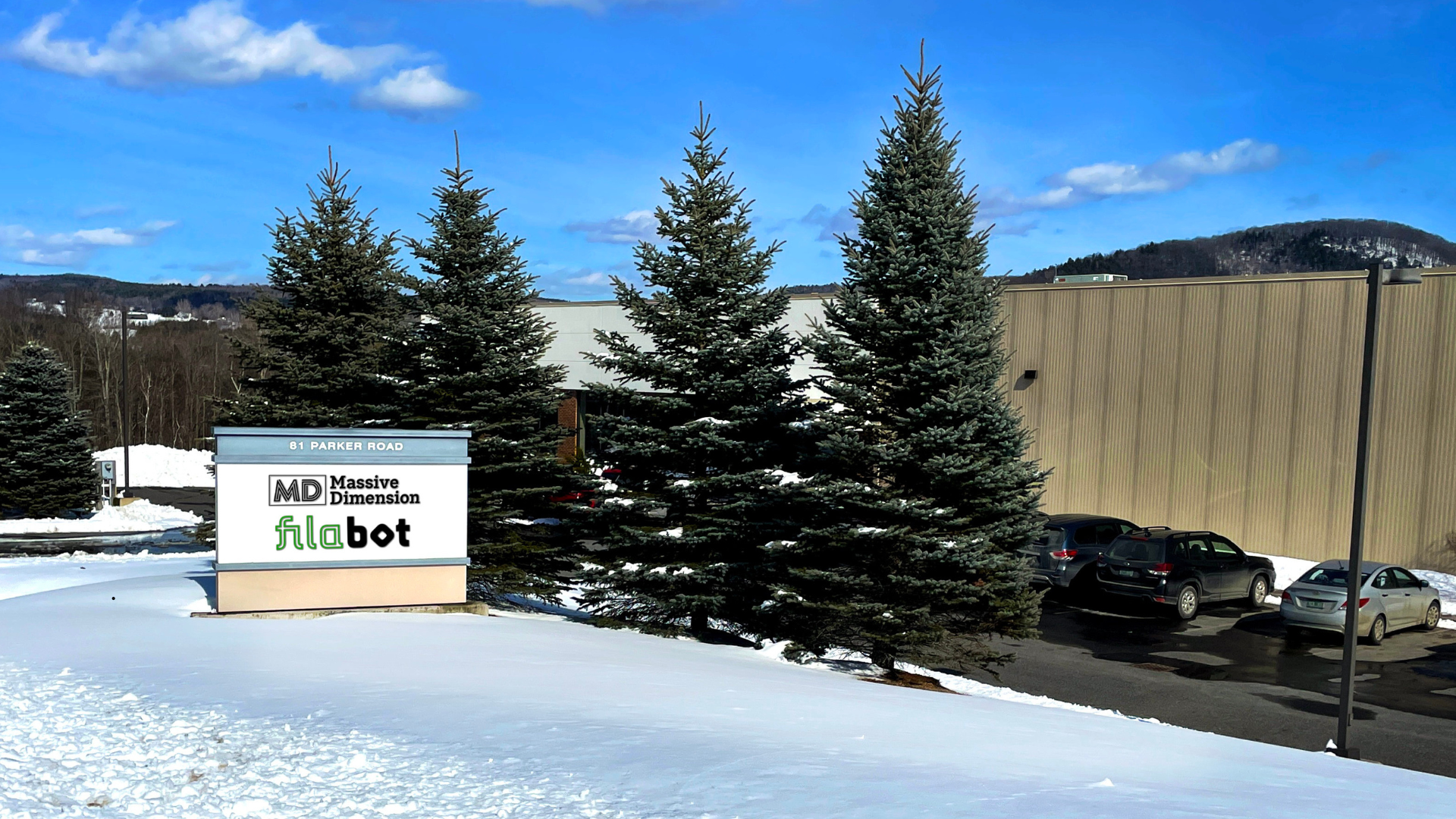We care about the materials we sell and the success of using our machines. This report was done with very extensive testing beyond what we typically do with the lab testing service we provide but a detailed processing report to give customers the best outcome, we hope that customers will take this and expand it. Work with faster settings, use additives, and get creative.
These test settings are based on studies our WBL Intern Jackson P. did. All settings were verified on a separate EX2 with identical results. Great work Jackson!
We also want customers to know that we will provide more test reports including the EX2.
PLA 3D870 Processing Report
Virgin 3D870 Polylactic Acid (PLA 3D870) was extruded in the EX2 to compare the polymer’s tolerances with different Filabot Accessories. From testing, we saw that the tolerances of the material improved when using the Melt Filter Nozzles. The best outcome we had when conducting the tests were observed when we used the Standard Melt Filter Nozzle. Further testing of the material will look into printability as well as strength comparisons.
About the material:
PLA 3D870 has been engineered by Natureworks specifically for 3D printing. This formula crystallizes faster than their other PLA compounds, which allows for accelerated printing speeds with less distortion. This formula also features increased heat resistance for 3D prints, higher than 3D850. 3D870 has all the great hallmarks of PLA, as it is made from renewable sources and is non-toxic.
Test Technician: Nasser Abdel-Fatah
Test Number(s): ET200811NA01-04
Plastic Name: PLA 3D870
Manufacturer: Nature Works LLC.
Supplier: Filabot.
Additives: None.
Material Form: Pellets Round, offwhite color.
Extrusion Test Notes
Material preparation: None.
Grinding: None.
Drying: Yes, 12hours 50C/122F.
Extrusion Setup: EX2. Airpath. Filameasure SPC Unit with Tablet, and Spooler.
Note on Extruder: New EX2s have a dampener fan on the side to adjust warmth for the Feed and barrel. All tests were done with the Fan “OPEN” this would allow the same performance as the previous version of the machine. Please note all Melt Filters used a 60 and a 20 Mesh insert.
Extrusion Results: The above test numbers were able to generate filament at 1.75mm with a tolerance of +0.05mm. The settings, speeds, and additions are in the correct range to generate filament.
Test Settings: Materials were extruded in the EX2 with the following settings:
Heat zone setting:
- 185 degrees Celsius Test Number: ET200811NA01
- 190 degrees Celsius Test Number: ET200811NA02
- 195 degrees Celsius Test Number: ET200811NA03
- 200 degrees Celsius Test Number: ET200811NA04
Airpath Settings:
- Number of Airpath’s: 1
- Fan Speed: 100%
- Magnets: 5 used along Airpath. End, Center, Front.
- Tape: No.
Spooler Settings (0.5kg spool):
- Drive: mid to slow
- Traverse: 30%
Notes on Equipment
The positioning of Equipment:
When extruding the polymer space the EX2 50mm (2in) away from the first Airpath, then space the Spooler 60cm (2-feet) between the Airpath and the Spooler.
About the Standard Melt Filter Nozzle:
The Filabot Melt Filter Nozzle is used to help decontaminate your recycled materials for a clean, consistent filament. This nozzle includes a stainless steel mesh screen to filter small contaminants that have slipped through the cleaning and grinding process. The filtering of these contaminants reduces the chances of clogging the printer nozzle.
About the Extended 2x Melt Filter Nozzle:
This “extra length” improves output consistency, keeping your filament extrusion to the appropriate range. Use 2X Melt Filter Nozzle to help decontaminate your recycled materials for a clean, consistent filament. The 2x nozzle improves laminar flow (less die stress at exit) and allows the filament to cool slightly during exit compared to stock. The 2x nozzle works best up to 50 volts.
About the Extended 3x Melt Filter Nozzle:
This “extra length” improves output consistency, keeping your filament extrusion to the appropriate range. Use 3X Melt Filter Nozzle to help decontaminate your recycled materials for a clean, consistent filament. The 3x nozzle improves laminar flow (less die stress at exit) and allows the filament to cool slightly during exit compared to stock.
Fans Setting:
- Open (All tests)
Power:
- 5/7 (All tests)
Nozzle Used:
- Standard Nozzle Test number: ET20811NA01
- Standard Melt Filter: Test number: ET200811NA02
- Extended (2X) Melt Filter Test Number: ET200811NA03
- Extended (3X) Melt Filter Test Number: ET200811NA04
- Size: 1.75mm (All tests)
- Mesh: 60/20 (All tests)
Results
Graph 1. Test: ET200811NA01. Stock Extrusion Testing Nozzle.
Once temperature and power were determined on the EX2, adjustments were made to the Spooler “drive” to improve the tolerances. From 09:00:00 to tick mark 09:05:00 on the graph (see Graph 1), the material was on the spool. At marker 09:15:00, spool adjustments were finished. The polymer was able to stay consistent for 20 mins before starting to swing to higher diameters. Currently, we cannot explain the swing that is seen between tick 09:15:00 and tick 09:20:00; there could have been material stuck to the screw or nozzle that came out. This issue did not occur again.
Graph 2. Test: ET200811NA02. PLA3D870 with a Standard Melt Filter.
Once temperature and power were determined on the EX2, adjustments were made to the Spooler “drive” to improve the tolerances. From 10:07:00 to tick mark 10:12:00 on the graph (see Graph 2), the material was on the spool. At marker 10:17:00 spool, adjustments were finished. The polymer was able to stay consistent for the duration of the test. Currently, we cannot explain the swings of a high diameter that is seen throughout the testing; more research is needed.
Graph 3.Test: ET200811NA03. PLA 3D870 2X Melt Filter.
Once temperature and power were determined on the EX2 adjustments were made to the Spooler “drive” to improve the tolerances. From 11:13:00 to tick mark 11:18:00 on the graph (see Graph 3), the material was on the spool, and adjustments were made to the drive. The material stayed within range the whole test. After 35mins (see tick mark 11:48:00), the filament started to rise in diameter; the Drive was not adjusted, and the material went back to normal ranges seen after.
Graph 4. Test: ET200811NA04. PLA 3D870 with 3X Melt Filter.
Once temperature and power were determined on the EX2 adjustments were made to the Spooler “drive” to improve the tolerances. From 12:33:00 to 12:34:00 (See Graph 4), the material was on the spool, and adjustments were made to the drive. The material stayed within range for 35mins. After 35mins (see mark 13:08:00), the material started to rise in diameter; this was due to the feed of PLA 3D870 getting low. From 13:08:00 to the end of the test, the Drive was adjusted until the extruder was dry.
To make sure the Nozzle on the extruder stayed warm, we took exhaust tape and wrapped it around the 3XNozzle this held the heat better for the polymer to extrude.
Links for More Information & Equipment:
- PLA 3D870: https://www.filabot.com/collections/filament/products/pla-pellets-3d870
- Standard Melt Filter: https://www.filabot.com/collections/components/products/melt-filter-nozzle-f
- Extended Melt Filter: https://www.filabot.com/collections/components/products/ex2-extended-melt-filter-nozzle
- EX2 Bundle:https://www.filabot.com/products/ex2-bundle
- Filalogger Bundle: https://www.filabot.com/collections/spooler/products/filameasure-inline-filament-measurement
Want to see more?
Send us an email at contact@filabot.com if you have any questions or would like to receive a folder with video samples from the test as well as screenshot and Excel data for the above tests.
Related Posts
Improve Filament Output Consistency with Melt Filter Nozzles
Use the Filabot Melt Filter Nozzle to help decontaminate your recycled materials for a clean, consistent filament. The stock nozzle is good for lower output applications where the voltage is under 25 volts.
The 2x nozzle performs better because it provides more laminar flow (less die stress at exit) and allows the filament to cool slightly during exit compared to stock. The 2x nozzle works up to 50 volts.
The 3x nozzle is used for very high index plastics like PET. It aids in the pull down on exit and allows the filament to cool even more than the 2x.
---------------------------------
FILAMEASURE Inline Filament Measurement and SPC Unit
Finally, the perfect way to measure filament while extruding. The Filabot Filameasure is the perfect addition to the Filabot Spooler, this addition mounts to the Filabot Spooler and measures freshly extruded filament.
The inline measurement allows for real time adjustments to dial in diameter for the best possible filament. No more need for consistent caliper checking with this tool. Another great feature of the Filameasure is the SPC Unit one can attach to it. With the Filalogger software one can record and save in real time filament spooled or polymers tested! This is upper handy for on the cuff adjustments and troubleshooting needs. The Filameasure and SPC unit will allow to compare and contrasts your data with other plastics and extruder settings to see what works best for you!
We feel very strongly about the value this addition can bring to you and your extrusion making! To help with the support of our product we have a couple YouTube videos you can check out here. Also, check out the Filameasure here on our website! Be on the lookout for new products to improve your recycling and extrusion needs!












